Comparison Study of Two Different Sun-Tracking Methods in Optical Efficiency of Heliostat Field
Abstract
There are two sun-tracking methods widely used for the heliostat, which are conventional Azimuth-Elevation and revolutionary Spinning-Elevation methods. Following the previous study to compare the range of motion, a comparison study in optical efficiency of heliostat field for the two methods is further explored in this paper. A special algorithm using ray-tracing technique has also been developed to simulate the optical efficiency of heliostat field for both sun-tracking methods in different latitudes. With the new algorithm, comprehensive analysis to compare the optical efficiency of individual heliostat and the overall heliostat field for the two sun-tracking methods has been carried out.
1. Introduction
Central receiver system (CRS) or central power tower is an attractive method to achieve tremendously huge power and high concentration of solar irradiance for electricity generation or thermal processes [1]. This system involves the use of many individual sun-tracking mirrors (or heliostats) to reflect and to superpose the concentrated sunlight at a common receiver attached on top of the central tower. The performance of the heliostat field is defined in terms of the optical efficiency which is the ratio of the net power absorbed by the receiver to the power incident normally on the field. The optical losses from the heliostat field take into account the losses due to the field layout, that is, cosine, shadowing and blocking, and losses due to other factors, that is, imperfect mirror reflectivity, atmospheric attenuation, and receiver spillage [2]. Although several number of heliostat field arrangement is possible, most of the heliostat field is designed in radial stagger pattern [3–6]. This arrangement ensures that no heliostat is consigned in front of another heliostat in adjacent rings along a spoke to the tower. Therefore, reflected beam from the heliostats can pass between adjacent neighbors direct to the receiver. Several studies have revealed that the radial stagger arrangement is the most efficient for a given land area as it cuts down the land usage and atmospheric attenuation losses. Hence, it contributes the most expedient distribution for heliostat fields [3, 7].
There are two major sun-tracking methods widely implemented in the heliostat, which are conventional method: Azimuth-Elevation (AE), and revolutionary method: Spinning-Elevation (SE) [8–19]. In AE tracking method, one of the tracking axes of the heliostat points towards the zenith, namely, azimuth axis while the other axis is perpendicular to the first axis and tangent to the heliostat frame called elevation axis. In SE tracking method, one of the tracking axes of the heliostat points towards the target, namely, spinning axis in order to maintain the heliostat normal within the tangential plane, while the other axis is perpendicular to the first axis and tangent to the heliostat frame in order to adjust the heliostat normal within the tangential plane until it bisects the sun position vector and the target position vector called elevation axis. Since the positions of the sun and the receiver are independent of the sun-tracking method, the only difference between the AE and SE tracking system is the utilization of different mechanism to rotate the heliostat frame to achieve same incident angle but different orientation so that both can aim the sunlight towards the receiver.
In the previous comparison study for the heliostat field, the SE method consumes 4.8–9.3% lesser power on the sun-tracking system and can also reduce the geometrical radius of solar image by about 30% compared to that of AE method [8, 9, 20]. As a result, we would like to further explore the potential of both sun-tracking methods in the aspect of the optical efficiency in the field layout. In the new study, the losses due to the field layout such as cosine, shadowing, and blocking effects of both sun-tracking methods are analyzed and compared in details. Despite the existence of many algorithms for the AE tracking method, that is, DELSOL3, HFLCAL, WinDELSOL1.0, SENSOL, and so forth, in optimizing the heliostat field layout, there is no any algorithm yet to be developed for the SE tracking method [21–23]. In this paper, a more generalized algorithm is developed based on ray-tracing technique for the edge rays to determine blocking and shadowing areas for both tracking methods. The methodology and various measures of the new algorithm to analyze the optical efficiency of the heliostat field for both methods are described in details too.
2. Methodology
2.1. Sun-Tracking Formulas
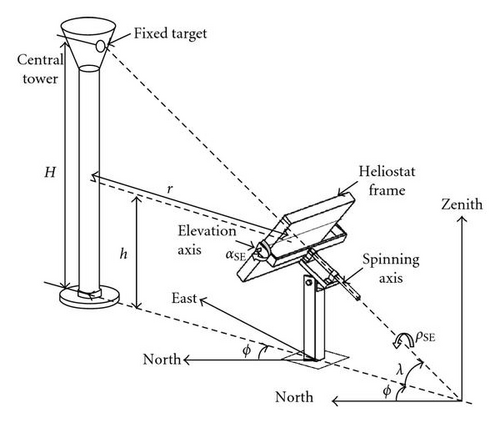
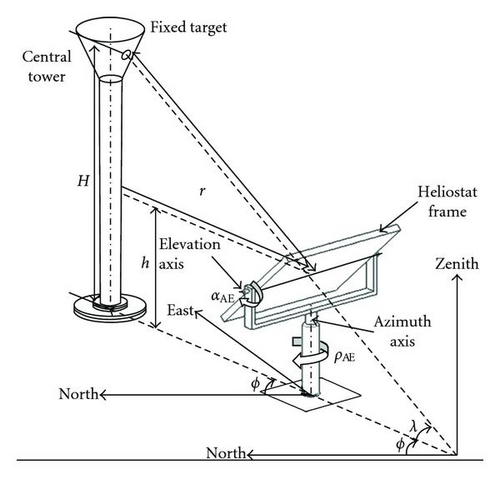
Where ϕ is the facing angle, λ is the target angle, Φ is the latitude, ω is the hour angle, δ is the declination angle; ϕ = 0° when the heliostat is due south of the target and it is positive value if the spinning axis is rotated from north to east direction; λ = 0° if the heliostat is of the same height as the target and it is positive value when the spinning axis is rotated so that the target is higher than the heliostat.
2.2. Coordinate Transformations of Heliostat
Given that the sun is an apparent moving object while the target is a fixed object, the heliostat frame has to be adjusted to follow the apparent change of the sun position with time. In this case, to resolve the blocking and shadowing effects between the heliostats, the orientation of the heliostat frame must be first identified. The instantaneous orientation of the heliostat frame during the period of sun tracking in three dimensional space can be modeled by applying the coordinate transformation. For the convenience of the three-dimensional coordinate transformation, one more dimensionality of space is added as to make all the transformations linear.
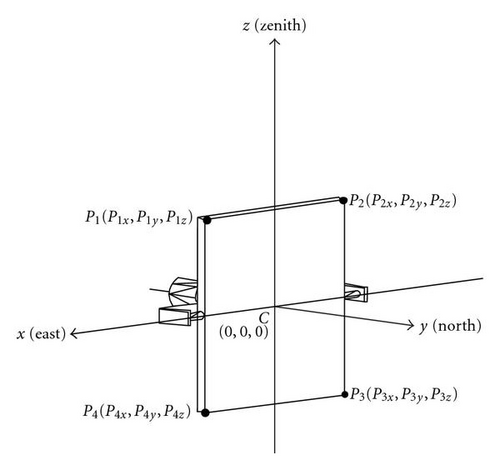
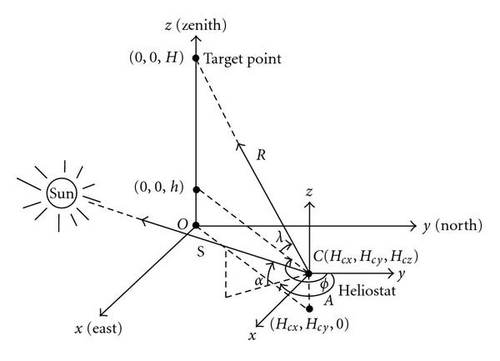
In the coordinate transformation for the AE sun-tracking method, we consider two angular movements of the heliostat frame relative to the azimuth and elevation axes and a translational transformation required to transform the position of heliostat frame from the local coordinate system to the global coordinate system.
2.3. Heliostat Field Layout
Heliostat field to be considered in our study consists of a central tower surrounded by 317 heliostats that are arranged into nine rings with radial stagger pattern surrounding the central tower. All the heliostats are packed together as close as possible with the precaution of collision avoidance for maximizing the packing factor of the field layout. The detailed specifications of field layout such as number of heliostat per ring, radial distance, and target angle are listed in Table 1. The heliostats located in the first four rings from the central tower, which are the 1st, 2nd, 3rd, and 4th ring, are nicely fitted into the ring with equal azimuthal spacing. For the following 5th, 6th, 7th, 8th, and 9th rings, the heliostats are also separated with equal azimuthal spacing except at the south field due to insufficient spacing for additional heliostats to be inserted.
| Total number of heliostats | 317 | ||||||||
| Reflective area of heliostat | 11 m × 11 m | ||||||||
| Target (or tower) height, H | 95 m | ||||||||
| Height of heliostat, h | 7 m | ||||||||
| Total reflective area of heliostat field | 38,357 m2 | ||||||||
| Total land area | 90,792.03 m2 (9.0792 hectare) | ||||||||
| Packing factor | 42.247% | ||||||||
| Ring number | 1 | 2 | 3 | 4 | 5 | 6 | 7 | 8 | 9 |
| Radial distances of heliostats from the central tower in meter, r | 61.3 | 74.6 | 86.6 | 97.2 | 114 | 127.6 | 140.5 | 152.8 | 164.3 |
| Target angle, λ | 55.16° | 49.72° | 45.45° | 42.15° | 37.67° | 34.60° | 32.06° | 29.94° | 28.18° |
| Field layout (number of heliostats per ring) | 24 | 24 | 24 | 24 | 44 | 44 | 44 | 44 | 45 |
2.4. Optical Efficiency of Heliostat
For comparing the optical efficiency of two sun-tracking methods in the field layout, there are three major factors including cosine, shadowing, and blocking effects to be considered in our algorithm. In this context, the reflectivity of mirror is assumed to be perfect and the atmospheric attenuation is ignored in the study inasmuch as its strong dependency on the local weather condition as well as the aerosol distribution at ground level [10]. Both factors are also independent on the sun-tracking method that is the prime consideration in our study. Furthermore, the receiver spillage loss is not included in the algorithm of designing field layout as well because it involves different measure of study by taking into account the receiver design and the geometry of heliostat reflector.
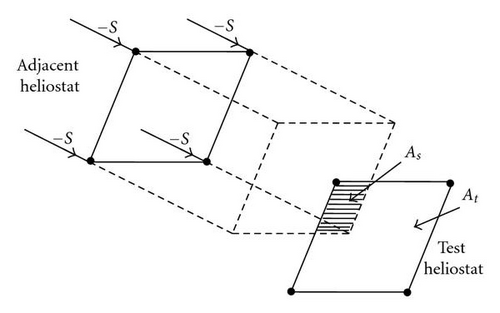
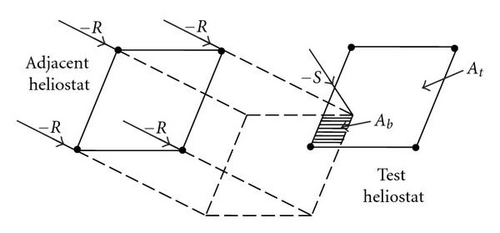
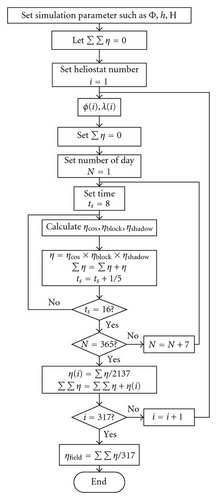
3. Result and Discussion
The simulation of the annual optical efficiency of heliostat field has been carried out to consider the cosine, shadowing, and blocking factors for both sun-tracking methods in different latitudes, that is, 0°, 15° N, 30° N. Figures 6(a) and 6(b) show the annual optical efficiency of individual heliostat in the field layout for a comparison of two methods at the latitude 0° (or at equator). The plots have shown that the annual optical efficiency for the heliostats in the east and west fields are perfectly symmetry as well as those in the south and the north fields. Furthermore, the annual optical efficiency of heliostats in north-south field is higher than those in east-west field. For the SE method, the annual optical efficiency of the individual heliostats is equal or higher than 77.5%. For AE method, the annual optical efficiency of the individual heliostat in this configuration is equal or higher than 75.0%. This figure has shown that SE method has an overall better optical efficiency than that of AE method at latitude 0°. For a comparison of two tracking methods, Figures 7(a), 7(b) and 8(a), 8(b) are also plotted to show the annual optical efficiency of heliostat field located at the latitude 15° N and 30° N, respectively. The simulated plots have shown that the annual optical efficiency of the east and west fields are perfectly symmetry regardless of sun-tracking methods. Nevertheless, it is asymmetry between north and south fields for both sun-tracking methods in which the north field has much higher annual optical efficiency than that of the south field. From our previous study for the range of motion, the characteristics of heliostat field located in the southern hemisphere can be implied from that of the northern hemisphere via rotating the heliostat field about the central tower by 180° because both of them are symmetry relative to the equator [9].
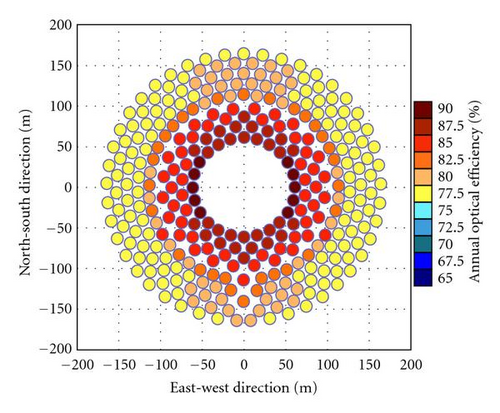
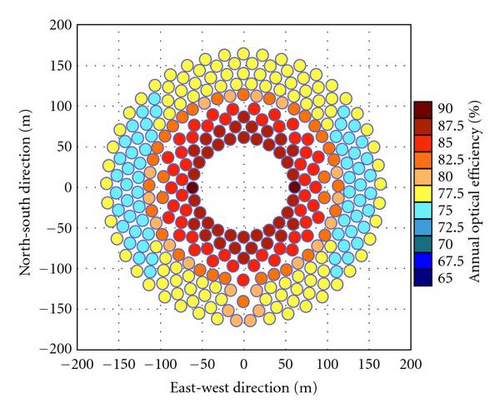
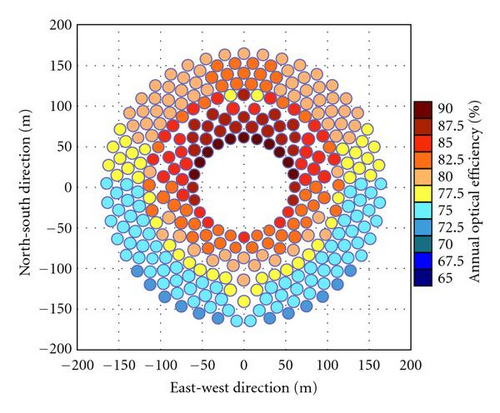
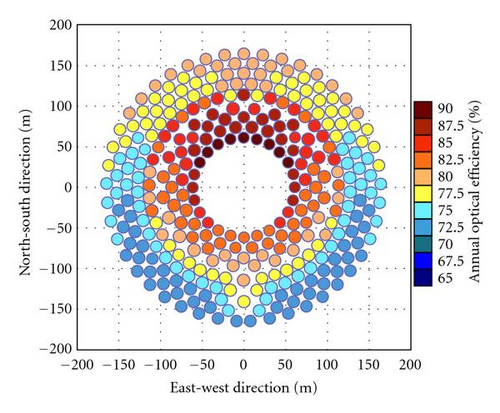
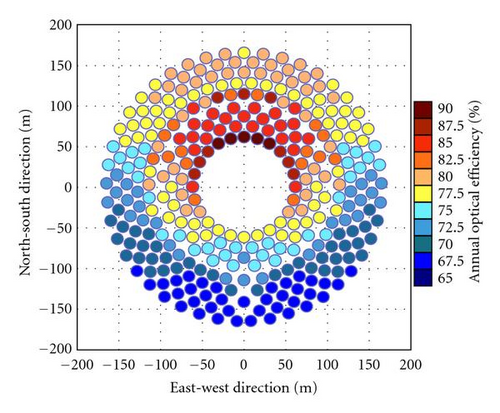
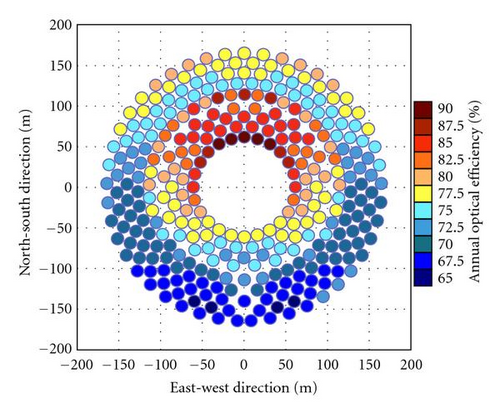
The simulated results for the annual optical efficiency of heliostat field for both sun-tracking methods at different latitudes, that is, 0°, 15° N, and 30° N, are summarized in Table 2. From the simulated result as revealed in Table 2, central tower system located at latitude at 0° has the highest annual optical efficiency of heliostat field compared to those of other latitudes. In addition, the latitude is inversely proportional to the annual field efficiency for both sun-tracking methods which means higher the latitude of the central power tower is located, the lower the optical efficiency of the heliostat field. All the efficiencies including cosine, blocking, and shadowing are the highest in equator and decrease with the latitude angle except the blocking efficiency for the AE method increases with the latitude angle.
| Latitude | SE | AE | ||||
|---|---|---|---|---|---|---|
| 0° | 15° N | 30° N | 0° | 15° N | 30° N | |
| Cosine efficiency | 84.99% | 84.45% | 82.86% | 84.99% | 84.45% | 82.86% |
| Blocking efficiency | 98.14% | 98.07% | 98.03% | 97.11% | 97.13% | 97.24% |
| Shadowing efficiency | 98.71% | 98.11% | 95.63% | 98.56% | 97.93% | 95.41% |
| Annual field efficiency, ηfield | 82.33% | 81.25% | 77.67% | 81.35% | 80.33% | 76.88% |
The cosine efficiency for both sun-tracking methods is equal to each other at all latitudes. This is because the positions of the sun, heliostats, and target are exactly the same for both methods which leads to the same incident and reflected angles. Table 2 also shows that SE sun-tracking method has better shadowing and blocking efficiency compared to that of AE sun-tracking method at all latitude. Generally, the annual optical efficiency for SE method is higher than that of AE method in all latitudes.
4. Conclusions
Study on the optical efficiency of heliostat field for two sun-tracking methods has been conducted in details. Moreover, the algorithm to compute the annual field efficiency for both methods has also been developed. For a comparison of two sun-tracking methods, the cosine efficiency is equal for both methods whilst SE method has better shadowing and blocking efficiency compared to that of AE method. Thus, the overall annual field efficiency of SE method is about 0.8–1% greater than that of AE method. On the other hand, all the components of annual optical efficiency including cosine, blocking, and shadowing are the highest in equator and decrease with the latitude angle.
Acknowledgments
The authors would like to express their gratitude to Fundamental Research Grant Scheme (FRGS) by the Ministry of Higher Education with project number FRGS/1/10/SG/UTAR/03/4 and UTAR Research Fund with project number IPSR/RMC/UTARRF/C2-10/C6 for the financial support in this study.




